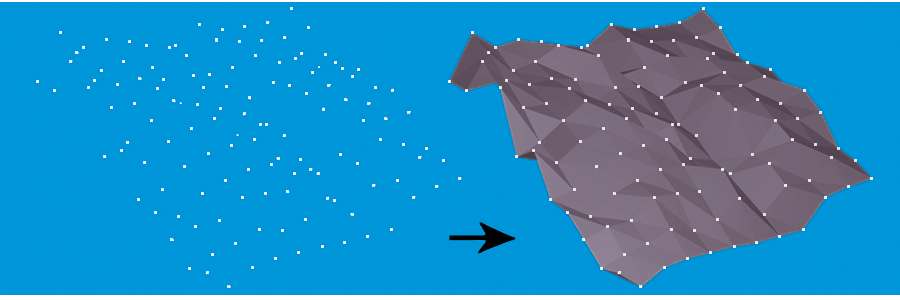Constructs a Delaunay triangulation based on input points and breaklines. The surface model may be output in a number of representations: a triangulated irregular network (TIN), TIN vertices, TIN edges, and triangles.
Input Ports
These input features may be 2D or 3D. Other than points, lines and area geometries, they may also be raster, point cloud, and aggregate geometries.
2D features will be forced to 3D by adding a z value of 0. In most cases, all points extracted from this port will be found in the vertex pool of the underlying surface model. A minimum of 3 unique points are required to construct a surface model. Points with duplicate x and y values will be dropped.
These input features may be 2D or 3D, and may reside inside an aggregate structure.
2D features will be forced to 3D by adding a z value of 0. Breakline edges will be found in the edge pool of the underlying surface model. Sometimes, a breakline edge will be split up to allow an optimal triangulation of the surface model. Points with duplicate x and y values will be dropped.
Output
This output port produces all the edges of the underlying surface model. Each edge feature contains the attributes _vertex1_id and _vertex2_id, which identify the vertices to which it is connected.
This output port produces all the triangles of the underlying surface model as polygons. Each output triangle has these attributes:
|
_vertex1_id _vertex2_id _vertex3_id |
identify the vertices that define the triangle |
| _slope | the slope of the plane defined by the triangle, in degrees, relative to the horizontal plane |
| _percentageSlope | the slope expressed as ( rise / run ) * 100%, or equivalently tan( _slope ) * 100% |
| _aspect | the aspect angle, in degrees, measured by the angle between nx and ny, where nx and ny are are the x and y components of the normal vector of the triangle |
This output port produces a single mesh geometry containing all the triangles of the underlying surface model.
This output port produces all of the vertices of the underlying surface model. Each vertex contains the attribute _vertex_id which uniquely identifies the vertex.
Parameters
This parameter allows groups to be formed by attribute values. Zero or more attributes may be specified.
Input features with the same attribute values are placed into the same group. The transformer then operates independently on each group of input features.
If this parameter is left blank, the transformer will treat the entire set of input features as one group.
Note: How parallel processing works with FME: see About Parallel Processing for detailed information.
This parameter determines whether or not the transformer should perform the work across parallel processes. If it is enabled, a process will be launched for each group specified by the Group By parameter.
Parallel Processing Levels
For example, on a quad-core machine, minimal parallelism will result in two simultaneous FME processes. Extreme parallelism on an 8-core machine would result in 16 simultaneous processes.
You can experiment with this feature and view the information in the Windows Task Manager and the Workbench Log window.
No: This is the default behavior. Processing will only occur in this transformer once all input is present.
By Group: This transformer will process input groups in order. Changes on the value of the Group By parameter on the input stream will trigger batch processing on the currently accumulating group. This will improve overall speed if groups are large/complex, but could cause undesired behavior if input groups are not truly ordered.
This parameter is used to determine which input points to add to the surface model as vertices. Specifying a value of 0 turns off vertex filtering.
Tip: A larger value will speed up surface model construction. The larger the value, the more input points will be filtered out. For input files with millions – or even billions – of points, it becomes essential to increase this value.
When a positive value for surface tolerance is specified, it works as follows. For each vertex that is being added to the model:
- If the x,y location is outside the 2D convex hull of the existing surface model, it is added to the model.
- If the x,y location is inside the 2D convex hull of the existing surface model:
- The difference between the z value from the existing surface model and the z value of the vertex is calculated.
- This difference is compared to the surface model tolerance.
- The vertex is only added to the surface model if the difference is greater than the surface tolerance; otherwise, the vertex is discarded.
Example

FME Licensing Level
FME Professional edition and above
Editing Transformer Parameters
Using a set of menu options, transformer parameters can be assigned by referencing other elements in the workspace. More advanced functions, such as an advanced editor and an arithmetic editor, are also available in some transformers. To access a menu of these options, click  beside the applicable parameter. For more information, see Transformer Parameter Menu Options.
beside the applicable parameter. For more information, see Transformer Parameter Menu Options.
Transformer Categories
Search FME Knowledge Center
Search for samples and information about this transformer on the FME Knowledge Center.
Tags Keywords: breakline morphology tessellate tessellation "surface model" TIN pointcloud